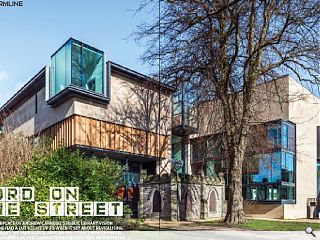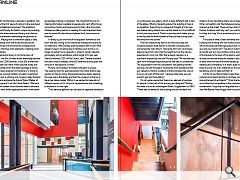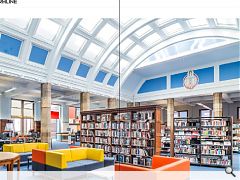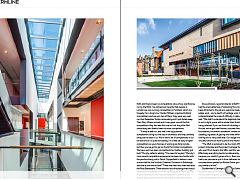Dunfermline: Word on the Street
10 Jul 2017
As the birthplace of Andrew Carnegie’s public library vision Dunfermline had a lot to live up to when it set about revitalising its own library. We take a look around the Carnegie Library & Galleries as Fife Council turn the page on a new chapter for borrowers and browsers alike.
Andrew Carnegie built a library in his home town of Dunfermline in 1883, the first of what would eventually become an estate of more than 2,500 libraries. It cost £5k at that time which in context is well over half a million pounds today and survives largely unscathed from the latest package of works, which is the fourth major extension to the library. In doing so Fife Council continues a proud tradition of public investment into the 21st century but is a library and museum really the best way for Dunfermline to embrace the future? David Walker of the Carnegie Development Trust told Urban Realm: “We have to move and adapt to modern time, libraries need to embrace the fact that people have online applications and I think books are perhaps making a comeback. The important thing is it’s making information available to people who can’t afford to go out and buy books and have access to them. At a time when children are falling behind in reading it’s more important than ever to ensure Dunfermline and places like it, have access to libraries.”
A library is just one third of the equation however as the town was also crying out for improved storage and access to its collections. With Dundee pushing ahead with its own V&A design museum investing big on facilities such as this is no longer an option but a necessity in order to remain relevant, particularly with an ambitious visitor target of 1m per year. Steve Grimmond, CEO of Fife Council, said: “Several hundred thousand visitors already come to Dunfermline every year, this will push it well beyond a million.”
Murphy commented: “Architecturally each is unique. The reading room for example draws from Alvar Aalto’s step section at Viipuri Library. Bookcases become desks opening the view out to the abbey and then the museum at the top is like a two storey casket. Within it we wanted to make lots of different spaces so it’s not just a big warehouse but something to explore in its own right.
“Two identical galleries can be used for separate exhibitions or combined as one gallery, which is quite different with a view of the abbey. What is interesting about the building is there is no repetition. Everything is unique and thought of in its own way before being slotted into a central street so it’s not difficult to find your way around. There’s a journey which takes you up to the top and the final moment of that journey is a big cube like window in the corner.”
From an unassuming start in an innocuous alley the museum presents itself behind a dramatic swinging door connected the main atrium. Taking the form of a rock fissure cleaving new from old, it has the height but not the volume expected of a civic hub. Was that a design decision or a constraint imposed by the site? Murphy said: “We had the idea right from the beginning because the site was so constrained. The big problem from the competition was getting into the building, we had the idea of hinging the front façade but that got vetoed by Historic Scotland so that prompted the council to buy a car park off the trust - because otherwise you just couldn’t get into the building.”
It’s not quite a secret but there is an element of surprise for people. Is that part of the journey you designed? Skirting the need to build an extravagant Bilbao, Guggenheim or V&A? “There was no elevation, the building site did not reach the street so it was inevitable unless you knocked down the bank. Other competitors did, Neil Gillespie knocked it down and opened up the street. There are two doors from the bank and Historic Scotland said ‘why can’t you use those?’ I said sure, but they don’t say ‘this is an entrance to a museum’ - that’s the issue.”
The scale of what’s been delivered and its complexity; building and working with two historic buildings, each of which has been painstakingly preserved, must have meant you had your hands full? “The atrium wasn’t too challenging, all we did was turn two windows into a door. The connection of the façade to the back of the bank is worth having a look at because we took away the rubble to slip the new façade of steel while we held the whole façade up. There’s a lot of detailing and complexity in it, that’s quite normal for us, but there are only two main materials on the outside; corten, ashlar sandstone a bit of glass but that’s it.”
Is it fair to say that architects raise their game for big cultural commission like this or do these commissions inspire the best of architects? “I think the fact that it was an architectural competition is the important bit of that conversation. Tragically not long after this competition was won Neil Baxter fired the guy who runs competitions at the RIAS and there’s been no competitions since of any significance run by the RIAS. I’ve noticed just recently that people in London are now running competitions in Scotland which is a tragedy. For a long time, Charles McKean organised brilliant competitions and we won two of them; they were very well run then Sebastien Tombs came along and it just faded away. Then Mary Wrenn arrived and it was great, one of the first competitions they had was this one but not long after Neil came along and there’s been no more competitions.
“If they’re well run, and that’s the big question, competitions bring out the best in architects and they certainly bring out the best in us. We’ve won a lot of competitions in our time and find it’s quite stimulating. I’m a little bit wary of open competitions as your chances of winning are fairly remote but then you’ve got to get on the list for limited competitions. We have won two open competitions but neither building got built,” Murphy reflects, adding: “You need to be paid.” Murphy’s more recent competition experience has been less fruitful with the practice losing out to David Chipperfield to deliver a new concert hall for the Scottish Chamber Orchestra in Edinburgh, was that a sore one to lose? “There was that one, there was also the Ross Bandstand. There are also lots of buildings that should have been competitions such as the Museum of Flight and The Archive Building for the National Galleries. In Germany and Austria every public building with public money has to be an architectural competition.”
Bruce Dickson, regional director at BAM Construction, had the unenviable task of delivering this vision having first been attracted to the job as a welcome break from school estate work - and a dearth of heritage work, but massively underestimated the scale of difficulty in delivering it. Dickson said: “We didn’t understand the logistical challenges of working in such a tight space with a whole listed building and façade being retained. If you can think of a building material it’s in this job, we’ve got steel frames, concrete frames, concrete foundations, brickwork, stonework, timber cladding, steel cladding, big areas of glazing and three different types of roofing all in a very small area. Our design manager worked virtually full time on how to join all the interfaces together.
“The V&A is reckoned to be the most difficult construction project in Europe and the project manager Kenny Hodgson, who went from here to the V&A, said this was harder. Effectively everything had to be delivered by transit van because you couldn’t get an artic in. Even concrete lorries had to be planned as just in time deliveries because with four concrete lorries parked on Abbott Street you’d bring the whole city centre to a halt.”
Dunfermline’s Carnegie Library and Galleries might be low key to the point of invisibility on approach but it stands tall on the shoulders of giants, proving to those who look beyond the cover that buildings don’t have to be bold and brash to make a big impact.
|
|
Read next: Gray Dunn: Factory Floored
Read previous: Employee Ownership: Owning Up
Back to July 2017
Browse Features Archive
Search
News
For more news from the industry visit our News section.
Features & Reports
For more information from the industry visit our Features & Reports section.






